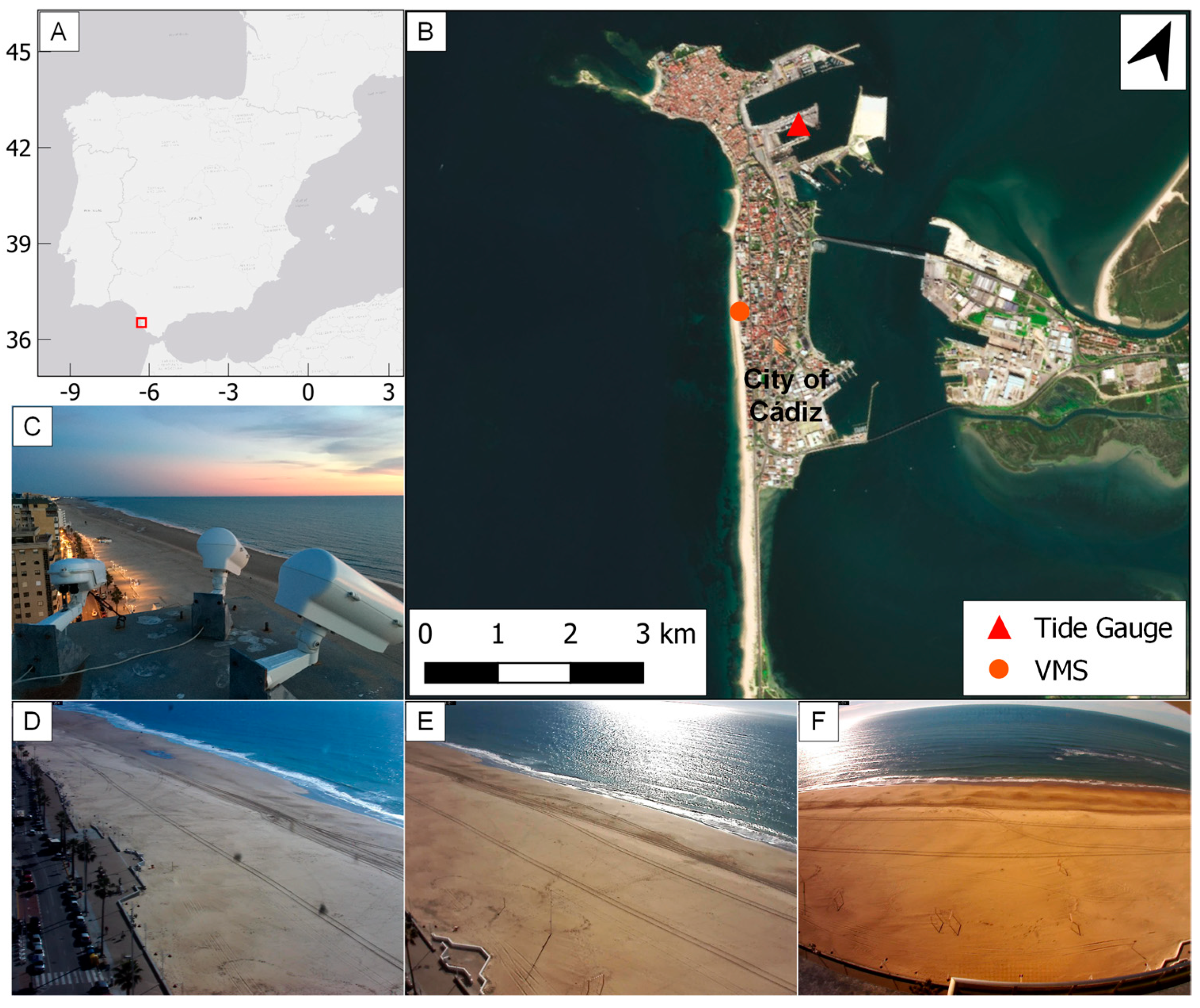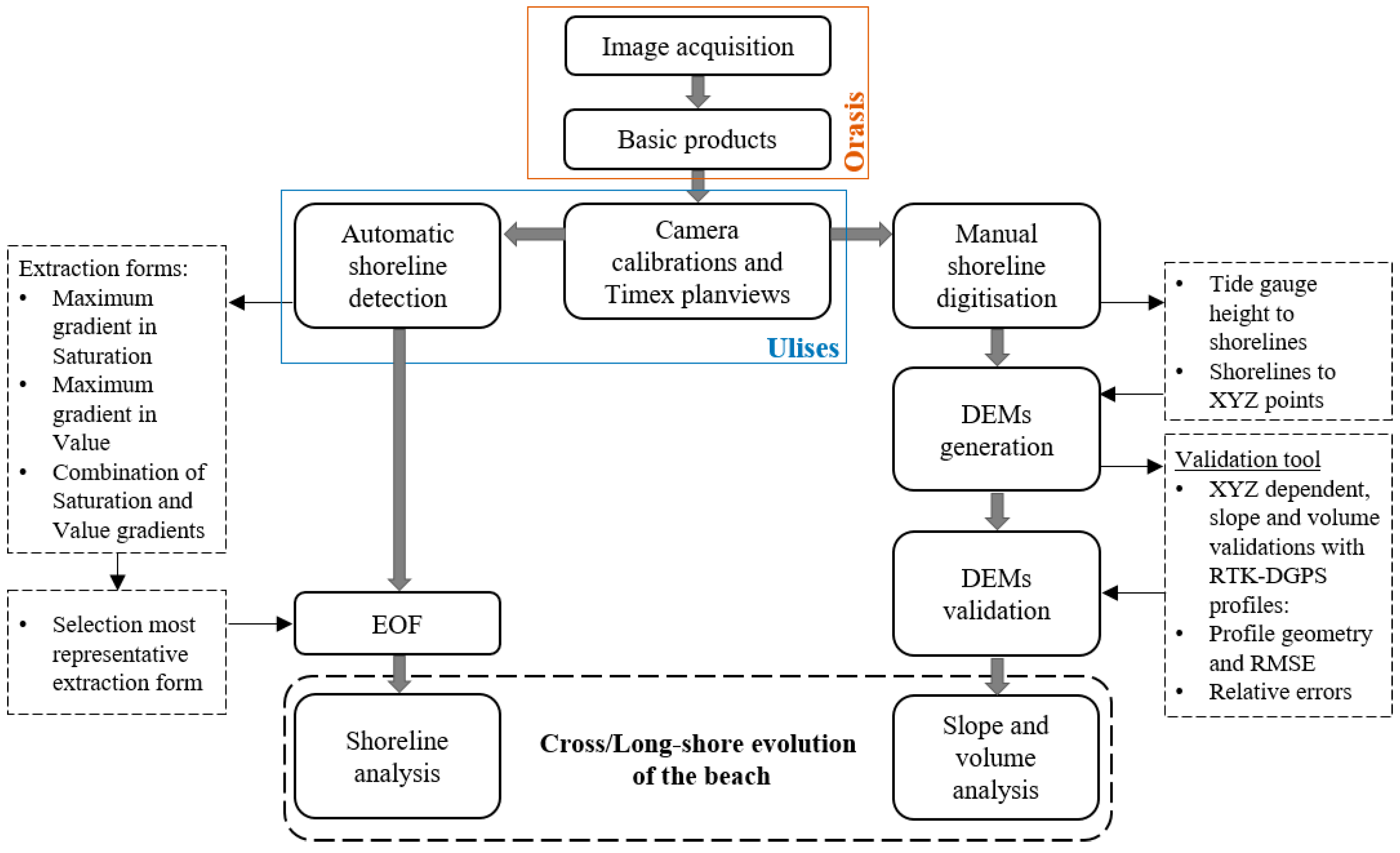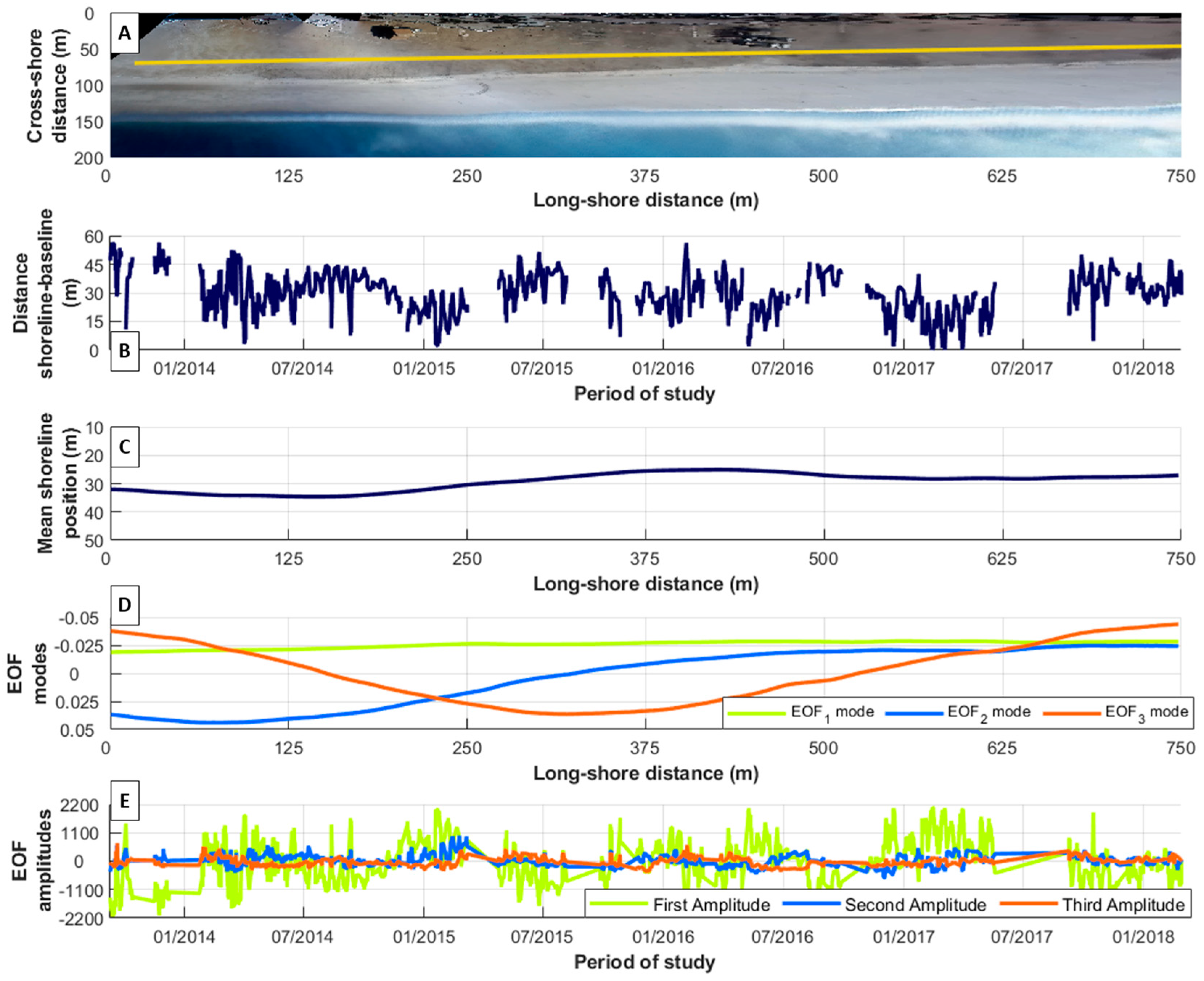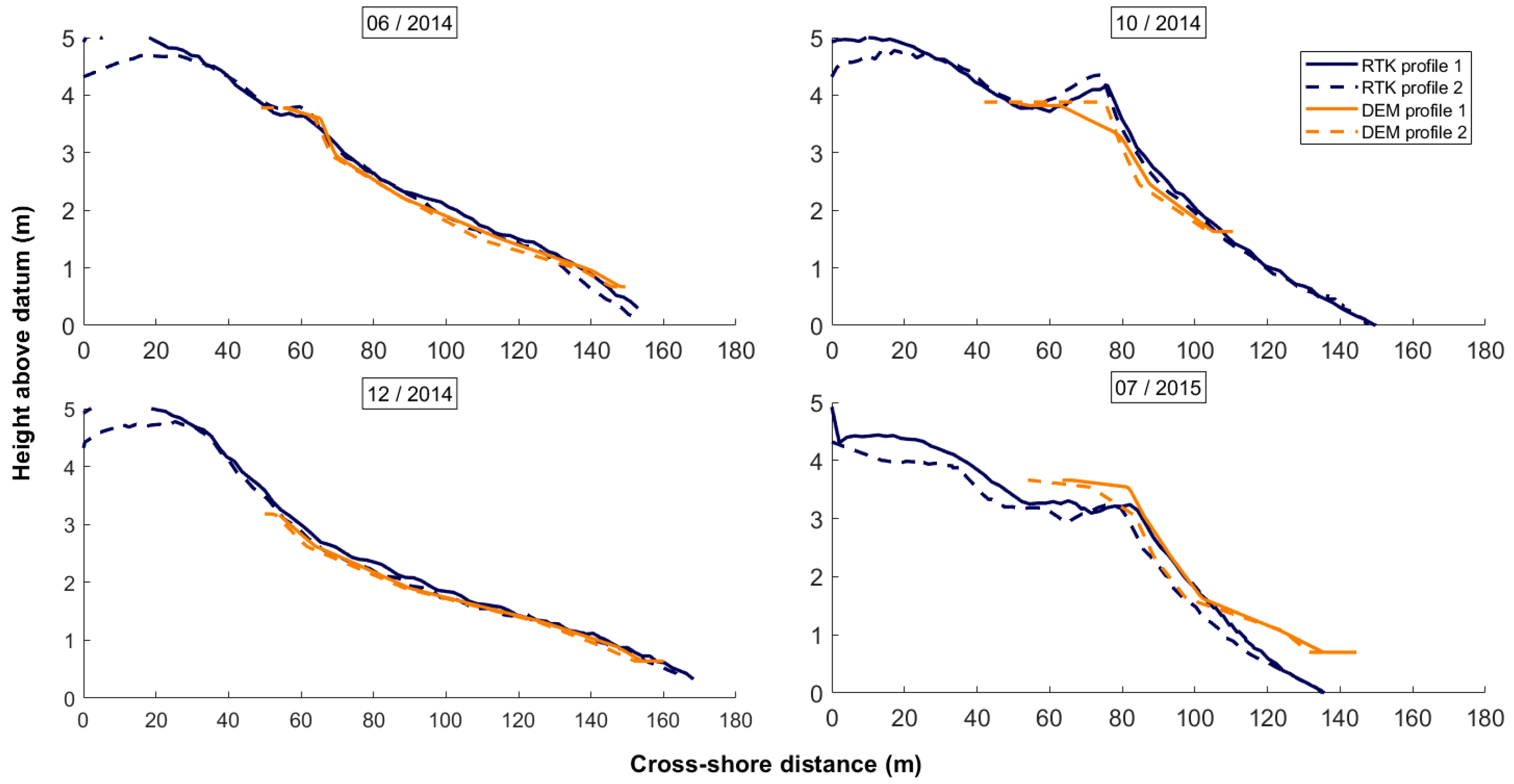Video-Monitoring Tools for Assessing Beach Morphodynamics in Tidal Beaches
Abstract
1. Introduction
2. Study Zone
3. Methodology
3.1. Automatic Shoreline Detection
3.2. DEM Generation
4. Results
4.1. Automatic Shoreline Extraction and Shoreline Analysis
4.2. DEM Generation and Validation
4.3. Slope and Volume Evolution
5. Discussion
5.1. Methodological Considerations
5.2. Beach Behaviour Analysis Based on Video-Monitoring Tools
6. Conclusions
Author Contributions
Funding
Data Availability Statement
Acknowledgments
Conflicts of Interest
References
- Todd, P.A.; Heery, E.C.; Loke, L.H.L.; Thurstan, R.H.; Kotze, D.J.; Swan, C. Towards an urban marine ecology: Characterizing the drivers, patterns and processes of marine ecosystems in coastal cities. Oikos 2019, 128, 1215–1242. [Google Scholar] [CrossRef]
- Cooley, S.; Schoeman, D.; Bopp, L.; Boyd, P.; Donner, S.; Ghebrehiwet, D.Y.; Ito, S.-I.; Kiessling, W.; Martinetto, P.; Ojea, E.; et al. Oceans and Coastal Ecosystems and Their Services. In Climate Change 2022: Impacts, Adaptation and Vulnerability. Contribution of Working Group II to the Sixth Assessment Report of the Intergovernmental Panel on Climate Change; Pörtner, H.-O., Roberts, D.C., Tignor, M., Poloczanska, E.S., Mintenbeck, K., Alegría, A., Craig, M., Langsdorf, S., Löschke, S., Möller, V., et al., Eds.; Cambridge University Press: Cambridge, UK; New York, NY, USA, 2022; pp. 379–550. ISBN 9781009325844. [Google Scholar]
- Vousdoukas, M.I.; Ranasinghe, R.; Mentaschi, L.; Plomaritis, T.A.; Athanasiou, P.; Luijendijk, A.; Feyen, L. Sandy coastlines under threat of erosion. Nat. Clim. Chang. 2020, 10, 260–263. [Google Scholar] [CrossRef]
- Cooper, J.A.G.; Masselink, G.; Coco, G.; Short, A.D.; Castelle, B.; Rogers, K.; Anthony, E.; Green, A.N.; Kelley, J.T.; Pilkey, O.H.; et al. Sandy beaches can survive sea-level rise. Nat. Clim. Chang. 2020, 10, 993–995. [Google Scholar] [CrossRef]
- Masselink, G.; Hegge, B. Morphodynamics of meso- and macrotidal beaches: Examples from central Queensland, Australia. Mar. Geol. 1995, 129, 1–23. [Google Scholar] [CrossRef]
- Russell, P.E. Mechanisms for beach erosion during storms. Cont. Shelf Res. 1993, 13, 1243–1265. [Google Scholar] [CrossRef]
- Karunarathna, H.; Pender, D.; Ranasinghe, R.; Short, A.D.; Reeve, D.E. The effects of storm clustering on beach profile variability. Mar. Geol. 2014, 348, 103–112. [Google Scholar] [CrossRef]
- Vos, K.; Harley, M.D.; Turner, I.L.; Splinter, K.D. Pacific shoreline erosion and accretion patterns controlled by El Niño/Southern Oscillation. Nat. Geosci. 2023, 16, 140–146. [Google Scholar] [CrossRef]
- Morton, R.A.; Leach, M.P.; Paine, J.G.; Cardoza, M.A. Monitoring beach changes using GPS surveying techniques. J. Coast. Res. 1993, 9, 702–720. [Google Scholar]
- Delgado, I.; Lloyd, G. A Simple Low Cost Method for One Person Beach Profiling. J. Coast. Res. 2004, 204, 1246–1252. [Google Scholar] [CrossRef]
- Guisado-Pintado, E.; Jackson, D.W.T.; Rogers, D. 3D mapping efficacy of a drone and terrestrial laser scanner over a temperate beach-dune zone. Geomorphology 2019, 328, 157–172. [Google Scholar] [CrossRef]
- Laignel, B.; Vignudelli, S.; Almar, R.; Becker, M.; Bentamy, A.; Benveniste, J.; Birol, F.; Frappart, F.; Idier, D.; Salameh, E.; et al. Observation of the Coastal Areas, Estuaries and Deltas from Space. Surv. Geophys. 2023. [Google Scholar] [CrossRef]
- Castelle, B.; Masselink, G.; Scott, T.; Stokes, C.; Konstantinou, A.; Marieu, V.; Bujan, S. Satellite-derived shoreline detection at a high-energy meso-macrotidal beach. Geomorphology 2021, 383, 107707. [Google Scholar] [CrossRef]
- Bergsma, E.W.J.; Almar, R. Coastal coverage of ESA’ Sentinel 2 mission. Adv. Space Res. 2020, 65, 2636–2644. [Google Scholar] [CrossRef]
- Holman, R.A.; Guza, R.T. Measuring run-up on a natural beach. Coast. Eng. 1984, 8, 129–140. [Google Scholar] [CrossRef]
- Lippmann, T.C.; Holman, R.A. The spatial and temporal variability of sand bar morphology. J. Geophys. Res. 1990, 95, 11575. [Google Scholar] [CrossRef]
- Austin, M.; Scott, T.; Brown, J.; Brown, J.; MacMahan, J.; Masselink, G.; Russell, P. Temporal observations of rip current circulation on a macro-tidal beach. Cont. Shelf Res. 2010, 30, 1149–1165. [Google Scholar] [CrossRef]
- Bracs, M.A.; Turner, I.L.; Splinter, K.D.; Short, A.D.; Lane, C.; Davidson, M.A.; Goodwin, I.D.; Pritchard, T.; Cameron, D. Evaluation of Opportunistic Shoreline Monitoring Capability Utilizing Existing “Surfcam” Infrastructure. J. Coast. Res. 2016, 319, 542–554. [Google Scholar] [CrossRef]
- Chickadel, C.C.; Holman, R.A.; Freilich, M.H. An optical technique for the measurement of longshore currents. J. Geophys. Res. Ocean. 2003, 108, 3364. [Google Scholar] [CrossRef]
- Sancho-García, A.; Guillén, J.; Ojeda, E. Storm-induced readjustment of an embayed beach after modification by protection works. Geo-Mar. Lett. 2013, 33, 159–172. [Google Scholar] [CrossRef]
- Armaroli, C.; Ciavola, P. Geomorphology Dynamics of a nearshore bar system in the northern Adriatic: A video-based morphological classi fi cation. Geomorphology 2011, 126, 201–216. [Google Scholar] [CrossRef]
- Pellón, E.; Garnier, R.; Medina, R. Intertidal finger bars at El Puntal, Bay of Santander, Spain: Observation and forcing analysis. Earth Surf. Dyn. 2014, 2, 349–361. [Google Scholar] [CrossRef]
- Splinter, K.D.; Gonzalez, M.V.G.; Oltman-shay, J.; Rutten, J.; Holman, R. Observations and modelling of shoreline and multiple sandbar behaviour on a high-energy meso-tidal beach. Cont. Shelf Res. 2018, 159, 33–45. [Google Scholar] [CrossRef]
- Almar, R.; Coco, G.; Bryan, K.R.; Huntley, D.A.; Short, A.D.; Senechal, N. Video observations of beach cusp morphodynamics. Mar. Geol. 2008, 254, 216–223. [Google Scholar] [CrossRef]
- Vousdoukas, M.I. Erosion/accretion patterns and multiple beach cusp systems on a meso-tidal, steeply-sloping beach. Geomorphology 2012, 141–142, 34–46. [Google Scholar] [CrossRef]
- Montes, J.; Simarro, G.; Benavente, J.; Plomaritis, T.A.; Del Río, L. Morphodynamics Assessment by Means of Mesoforms and Video-Monitoring in a Dissipative Beach. Geosciences 2018, 8, 448. [Google Scholar] [CrossRef]
- Vousdoukas, M.I.; Wziatek, D.; Almeida, L.P. Coastal vulnerability assessment based on video wave run-up observations at a mesotidal, steep-sloped beach. Ocean Dyn. 2012, 62, 123–137. [Google Scholar] [CrossRef]
- Simarro, G.; Bryan, K.R.; Guedes, R.M.C.; Sancho, A.; Guillen, J.; Coco, G. On the use of variance images for runup and shoreline detection. Coast. Eng. 2015, 99, 136–147. [Google Scholar] [CrossRef]
- Sancho-García, A.; Ruessink, B.G.; Guillén, J. Storm-surge inundation along a multibarred beach. J. Coast. Res. 2011, SI 64, 1911–1915. [Google Scholar]
- Stockdon, H.F.; Holman, R.A. Estimation of wave phase speed and nearshore bathymetry from video imagery. J. Geophys. Res. Ocean. 2000, 105, 22015–22033. [Google Scholar] [CrossRef]
- Vousdoukas, M.I.; Ferreira, P.M.; Almeida, L.P.; Dodet, G.; Psaros, F.; Andriolo, U.; Taborda, R.; Silva, A.; Ruano, A.; Ferreira, Ó. Performance of intertidal topography video monitoring of a meso-tidal reflective beach in South Portugal. Ocean Dyn. 2011, 61, 1521–1540. [Google Scholar] [CrossRef]
- Simarro, G.; Calvete, D.; Plomaritis, T.A.; Moreno-Noguer, F.; Giannoukakou-Leontsini, I.; Montes, J.; Durán, R. The Influence of Camera Calibration on Nearshore Bathymetry Estimation from UAV Videos. Remote Sens. 2021, 13, 150. [Google Scholar] [CrossRef]
- Winant, C.D.; Inman, D.L.; Nordstrom, C.E. Description of seasonal beach changes using empirical eigenfunctions. J. Geophys. Res. 1975, 80, 1979–1986. [Google Scholar] [CrossRef]
- Larson, M.; Capobianco, M.; Jansen, H.; Rózyński, G.; Southgate, H.N.; Stive, M.; Wijnberg, K.M.; Hulscher, S. Analysis and Modeling of Field Data on Coastal Morphological Evolution over Yearly and Decadal Time Scales. Part 1: Background and Linear Techniques. J. Coast. Res. 2003, 19, 760–775. [Google Scholar]
- Kroon, A.; Larson, M.; Möller, I.; Yokoki, H.; Rozynski, G.; Cox, J.; Larroude, P. Statistical analysis of coastal morphological data sets over seasonal to decadal time scales. Coast. Eng. 2008, 55, 581–600. [Google Scholar] [CrossRef]
- Harley, M.D.; Turner, I.L.; Short, A.D.; Ranasinghe, R. A reevaluation of coastal embayment rotation: The dominance of cross-shore versus alongshore sediment transport processes, Collaroy-Narrabeen Beach, southeast Australia. J. Geophys. Res. 2011, 116, F04033. [Google Scholar] [CrossRef]
- Zhang, R.; Chen, L.; Liu, S.; Zhang, H.; Gong, W.; Lin, G. Shoreline evolution in an embayed beach adjacent to tidal inlet: The impact of anthropogenic activities. Geomorphology 2019, 346, 106856. [Google Scholar] [CrossRef]
- Del Río, L.; Plomaritis, T.A.; Benavente, J.; Valladares, M.; Ribera, P. Establishing storm thresholds for the Spanish Gulf of Cádiz coast. Geomorphology 2012, 143–144, 13–23. [Google Scholar] [CrossRef]
- Benavente, J.; Plomaritis, T.A.; Del Río, L.; Puig, M.; Valenzuela, C.; Minuzzi, B.; Del Río, L.; Puig, M.; Valenzuela, C.; Minuzzi, B. Differential short- and medium-term behavior of two sections of an urban beach. J. Coast. Res. 2014, 70, 621–626. [Google Scholar] [CrossRef]
- Muñoz-Pérez, J.J.; Medina, R. Comparison of long-, medium- and short-term variations of beach profiles with and without submerged geological control. Coast. Eng. 2010, 57, 241–251. [Google Scholar] [CrossRef]
- Benavente, J.; Borja, F.; Gracia, F.J.; Rodríguez, A. Introduction to the Gulf of Cadiz coast. In Geomorphology of the South-Atlantic Spanish Coast. Guide for Fieldtrip A4, Proceedings of the 6th International Conference on Geomorphology, Zaragoza, Spain, 7–11 September 2005; Gracia, F.J., Ed.; Universidad de Zaragoza: Zaragoza, Spain, 2005; pp. 1–11. [Google Scholar]
- Del Río, L.; Gracia, F.J.; Benavente, J. Morphological and evolutionary classification of sandy beaches in Cadiz coast (SW Spain). J. Coast. Res. 2013, 65, 2113–2118. [Google Scholar] [CrossRef]
- Plomaritis, T.A.; Benavente, J.; Del Río, L.; Reyes, E.; Dastis, C.; Gómez, M.; Bruno, M. Storm early warning system as a last plug-in of a regional operational oceanography system: The case of the gulf of Cádiz. Int. Conf. Coastal. Eng. 2012, 1, management.54. [Google Scholar] [CrossRef]
- Puig, M.; Del Río, L.; Plomaritis, T.A.; Benavente, J. Contribution of storms to shoreline changes in mesotidal dissipative beaches: Case study in the Gulf of Cádiz (SW Spain). Nat. Hazards Earth Syst. Sci. 2016, 16, 2543–2557. [Google Scholar] [CrossRef]
- Instituto Hidrográfico de la Marina. Anuario de Mareas. Available online: https://armada.defensa.gob.es/ArmadaPortal/page/Portal/ArmadaEspannola/cienciaihm1/prefLang-es/02ProductosServicios--08InfoInteres--04infoAnuario (accessed on 15 May 2021).
- Simarro, G.; Ribas, F.; Álvarez, A.; Guillén, J.; Chic, Ò.; Orfila, A. ULISES: An Open Source Code for Extrinsic Calibrations and Planview Generations in Coastal Video Monitoring Systems. J. Coast. Res. 2017, 335, 1217–1227. [Google Scholar] [CrossRef]
- Ribas, F.; Simarro, G.; Arriaga, J.; Luque, P. Automatic shoreline detection from video images by combining information from different methods. Remote Sens. 2020, 12, 3717. [Google Scholar] [CrossRef]
- Aarninkhof, S.G.J.; Turner, I.L.; Dronkers, T.D.T.; Caljouw, M.; Nipius, L. A video-based technique for mapping intertidal beach bathymetry. Coast. Eng. 2003, 49, 275–289. [Google Scholar] [CrossRef]
- Huisman, C.E.; Bryan, K.R.; Coco, G.; Ruessink, B.G. The use of video imagery to analyse groundwater and shoreline dynamics on a dissipative beach. Cont. Shelf Res. 2011, 31, 1728–1738. [Google Scholar] [CrossRef]
- Lorenz, E.N. Empirical Orthogonal Functions and Statistical Weather Prediction; Massachusetts Institute of Technology, Department of Meteorology: Cambridge, MA, USA, 1956. [Google Scholar]
- Álvarez-Ellacuría, A.; Orfila, A.; Gómez-Pujol, L.; Simarro, G.; Obregon, N. Decoupling spatial and temporal patterns in short-term beach shoreline response to wave climate. Geomorphology 2011, 128, 199–208. [Google Scholar] [CrossRef]
- Hannachi, A.; Jolliffe, I.T.; Stephenson, D.B. Empirical orthogonal functions and related techniques in atmospheric science: A review. Int. J. Climatol. 2007, 27, 1119–1152. [Google Scholar] [CrossRef]
- Muñoz-Pérez, J.J.; Medina, R. Profile changes due to a fortnightly tidal cycle. In Proceedings of the International Conference on Coastal Engineering (ASCE), Sydney, Australia, 16–21 July 2000; pp. 3063–3075. [Google Scholar]
- Muñoz-Pérez, J.J.; Tejedor, B. Las funciones empíricas ortogonales y los cambios en el perfil de playa a corto, medio, y largo plazo. Física Tierra 2001, 13, 139–166. [Google Scholar]
- Uunk, L.; Wijnberg, K.M.; Morelissen, R. Automated mapping of the intertidal beach bathymetry from video images. Coast. Eng. 2010, 57, 461–469. [Google Scholar] [CrossRef]
- Red Mareógrafica del IEO. Available online: http://indamar.ieo.es/mareas/formulario_datos.htm (accessed on 15 May 2021).
- Ferreira, Ó.; Plomaritis, T.A.; Costas, S. Effectiveness assessment of risk reduction measures at coastal areas using a decision support system: Findings from Emma storm. Sci. Total Environ. 2019, 657, 124–135. [Google Scholar] [CrossRef]
- McCall, R.T.; van Thiel de Vries, J.S.M.; Plant, N.G.; Van Dongeren, A.R.; Roelvink, J.A.; Thompson, D.M.; Reniers, A.J.H.M. Two-dimensional time dependent hurricane overwash and erosion modeling at Santa Rosa Island. Coast. Eng. 2010, 57, 668–683. [Google Scholar] [CrossRef]
- van Rijn, L.C.; Walstra, D.J.R.; Grasmeijer, B.; Sutherland, J.; Pan, S.; Sierra, J.P. The predictability of cross-shore bed evolution of sandy beaches at the time scale of storms and seasons using process-based profile models. Coast. Eng. 2003, 47, 295–327. [Google Scholar] [CrossRef]
- Smallegan, S.M.; Irish, J.L.; van Dongeren, A.R.; Den Bieman, J.P. Morphological response of a sandy barrier island with a buried seawall during Hurricane Sandy. Coast. Eng. 2016, 110, 102–110. [Google Scholar] [CrossRef]
- Sutherland, J.; Peet, A.H.; Soulsby, R.L. Evaluating the performance of morphological models. Coast. Eng. 2004, 51, 917–939. [Google Scholar] [CrossRef]
- Roelvink, D.; Reniers, A.; van Dongeren, A.R.; van Thiel de Vries, J.S.M.; McCall, R.; Lescinski, J. Modelling storm impacts on beaches, dunes and barrier islands. Coast. Eng. 2009, 56, 1133–1152. [Google Scholar] [CrossRef]
- Casella, E.; Rovere, A.; Pedroncini, A.; Stark, C.P.; Casella, M.; Ferrari, M.; Firpo, M. Drones as tools for monitoring beach topography changes in the Ligurian Sea (NW Mediterranean). Geo-Mar. Lett. 2016, 36, 151–163. [Google Scholar] [CrossRef]
- Talavera, L.; Del Río, L.; Benavente, J.; Barbero, L.; López-Ramírez, J.A. UAS & SfM-based approach to Monitor Overwash Dynamics and Beach Evolution in a Sandy Spit. J. Coast. Res. 2018, 85, 221–225. [Google Scholar] [CrossRef]
- Armaroli, C.; Ciavola, P.; Balouin, Y.; Gatti, M. An Integrated Study of Shoreline Variability Using GIS and ARGUS Techniques. J. Coast. Res. 2004, 39, 473–477. [Google Scholar]
- Aarninkhof, S.G.J.; Roelvink, J.A. Argus-based monitoring of intertidal beach morphodynamics. In Proceedings of the Coastal Sediments Conference, Long Island, NY, USA, 21–23 June 1999; Edge, B.E., Ed.; ASCE: New York, NY, USA, 1999. [Google Scholar]
- Aarninkhof, S.G.J. Nearshore Bathymetry Derived from Video Imagery; Delft University of Technology: Delft, The Netherlands, 2003. [Google Scholar]
- Plant, N.G.; Holman, R.A. Intertidal beach profile estimation using video images. Mar. Geol. 1997, 140, 1–24. [Google Scholar] [CrossRef]
- Plant, N.G.; Aarninkhof, S.G.J.; Turner, I.L.; Kingston, K.S. The Performance of Shoreline Detection Models Applied to Video Imagery. J. Coast. Res. 2007, 233, 658–670. [Google Scholar] [CrossRef]
- Aarninkhof, S.G.J.; Ruessink, B.G.; Roelvink, J.A. Nearshore subtidal bathymetry from time-exposure video images. J. Geophys. Res. 2005, 110. [Google Scholar] [CrossRef]
- Holman, R.; Plant, N.G.; Holland, T. cBathy: A robust algorithm for estimating nearshore bathymetry. J. Geophys. Res. Ocean. 2013, 118, 2595–2609. [Google Scholar] [CrossRef]
- Simarro, G.; Calvete, D.; Luque, P.; Orfila, A.; Ribas, F. UBathy: A new approach for bathymetric inversion from video imagery. Remote Sens. 2019, 11, 2722. [Google Scholar] [CrossRef]
- Bergsma, E.; Conley, D.; Davidson, M.; O’Hare, T.; Almar, R. Storm Event to Seasonal Evolution of Nearshore Bathymetry Derived from Shore-Based Video Imagery. Remote Sens. 2019, 11, 519. [Google Scholar] [CrossRef]
- Santos, D.; Abreu, T.; Silva, P.A.; Santos, F.; Baptista, P. Nearshore Bathymetry Retrieval from Wave-Based Inversion for Video Imagery. Remote Sens. 2022, 14, 2155. [Google Scholar] [CrossRef]
- Poelhekke, L.; Jäger, W.S.; van Dongeren, A.R.; Plomaritis, T.A.; McCall, R.; Ferreira, Ó. Predicting coastal hazards for sandy coasts with a Bayesian Network. Coast. Eng. 2016, 118, 21–34. [Google Scholar] [CrossRef]
- Donnelly, C.; Kraus, N.; Larson, M. State of Knowledge on Measurement and Modeling of Coastal Overwash. J. Coast. Res. 2006, 224, 965–991. [Google Scholar] [CrossRef]
- Duo, E.; Chris Trembanis, A.; Dohner, S.; Grottoli, E.; Ciavola, P. Local-scale post-event assessments with GPS and UAV-based quick-response surveys: A pilot case from the Emilia-Romagna (Italy) coast. Nat. Hazards Earth Syst. Sci. 2018, 18, 2969–2989. [Google Scholar] [CrossRef]
- Aguilar, F.J.; Mills, J.P.; Delgado, J.; Aguilar, M.A.; Negreiros, J.G.; Pérez, J.L. Modelling vertical error in LiDAR-derived digital elevation models. ISPRS J. Photogramm. Remote Sens. 2010, 65, 103–110. [Google Scholar] [CrossRef]
- Baptista, P.; Bastos, L.; Bernardes, C.; Cunha, T.; Dias, J. Monitoring Sandy Shores Morphologies by DGPS—A Practical Tool to Generate Digital Elevation Models. J. Coast. Res. 2008, 246, 1516–1528. [Google Scholar] [CrossRef]
- Benavente, J.; Gracia, F.J.; López-Aguayo, F. Empirical model of morphodynamic beachface behaviour for low-energy mesotidal environments. Mar. Geol. 2000, 167, 375–390. [Google Scholar] [CrossRef]
- Plomaritis, T.A.; Benavente, J.; Laiz, I.; Del Río, L. Variability in storm climate along the Gulf of Cadiz: The role of large scale atmospheric forcing and implications to coastal hazards. Clim. Dyn. 2015, 45, 2499–2514. [Google Scholar] [CrossRef]
- Benavente, J.; Del Río, L.; Anfuso, G.; Gracia, F.J.; Reyes, J.L. Utility of Morphodynamic Characterisation in the Prediction of Beach Damage by Storms. J. Coast. Res. 2002, 36, 56–64. [Google Scholar] [CrossRef]
- Muñoz-Pérez, J.J.; Tejedor, L.; Medina, R. Equilibrium beach profile model for perched beaches. J. Coast. Res. 1999, 15, 950–957. [Google Scholar] [CrossRef]
- Jackson, D.W.T.; Cooper, J.A.G.; Del Río, L. Geological control of beach morphodynamic state. Mar. Geol. 2005, 216, 297–314. [Google Scholar] [CrossRef]
- Gallop, S.L.; Bosserelle, C.; Pattiaratchi, C.; Eliot, I. Rock topography causes spatial variation in the wave, current and beach response to sea breeze activity. Mar. Geol. 2011, 290, 29–40. [Google Scholar] [CrossRef]
- Ranasinghe, R.; Turner, I.L.; Symonds, G. Shoreline response to multi-functional artificial surfing reefs: A numerical and physical modelling study. Coast. Eng. 2006, 53, 589–611. [Google Scholar] [CrossRef]
- Gallop, S.L.; Bosserelle, C.; Eliot, I.; Pattiaratchi, C.B. The influence of limestone reefs on storm erosion and recovery of a perched beach. Cont. Shelf Res. 2012, 47, 16–27. [Google Scholar] [CrossRef]
- Vousdoukas, M.I.; Velegrakis, A.F.; Plomaritis, T.A. Beachrock occurrence, characteristics, formation mechanisms and impacts. Earth-Sci. Rev. 2007, 85, 23–46. [Google Scholar] [CrossRef]
- López-Dóriga, U.; Jiménez, J.A.; Bisaro, A.; Hinkel, J. Financing and implementation of adaptation measures to climate change along the Spanish coast. Sci. Total Environ. 2020, 712, 135685. [Google Scholar] [CrossRef] [PubMed]









| Survey Index | RTK-DGPS Survey Date | DEM Date |
|---|---|---|
| 1 | 23-09-2013 | 19-09-2013 |
| 2 | 03-10-2013 | 06-10-2013 |
| 3 | 03-12-2013 | 04-12-2013 |
| 4 | 31-01-2014 | 31-01-2014 |
| 5 | 18-06-2014 | 14-06-2014 |
| 6 | 09-10-2014 | 09-10-2014 |
| 7 | 25-11-2014 | 24-11-2014 |
| 8 | 03-12-2014 | 06-12-2014 |
| 9 | 02-07-2015 | 04-07-2015 |
| Survey Index | Geometry Errors | |||||||||
|---|---|---|---|---|---|---|---|---|---|---|
| R | SCI | RelBias | BSS | RMSE | ||||||
| P1 | P2 | P1 | P2 | P1 | P2 | P1 | P2 | P1 | P2 | |
| 1 | 0.98 | 0.97 | 0.08 | 0.09 | 0.04 | 0.02 | 0.97 | 0.94 | 0.23 | 0.26 |
| 2 | 0.98 | 0.99 | 0.08 | 0.1 | 0.03 | −0.02 | 0.96 | 0.96 | 0.2 | 0.23 |
| 3 | 1 | 0.97 | 0.13 | 0.17 | −0.09 | −0.12 | 0.97 | 0.94 | 0.3 | 0.36 |
| 4 | 0.98 | 0.99 | 0.14 | 0.14 | 0.1 | 0.13 | 0.95 | 0.99 | 0.31 | 0.36 |
| 5 | 0.99 | 0.99 | 0.05 | 0.06 | −0.02 | −0.02 | 0.99 | 0.98 | 0.12 | 0.14 |
| 6 | 0.96 | 0.98 | 0.09 | 0.08 | −0.06 | −0.06 | 0.93 | 0.97 | 0.30 | 0.26 |
| 7 | 0.98 | 0.97 | 0.1 | 0.11 | 0.01 | −0.02 | 0.96 | 0.95 | 0.22 | 0.23 |
| 8 | 0.99 | 0.99 | 0.05 | 0.04 | −0.05 | −0.03 | 0.99 | 0.99 | 0.10 | 0.08 |
| 9 | 0.97 | 0.97 | 0.17 | 0.19 | 0.13 | 0.16 | 0.95 | 0.96 | 0.48 | 0.47 |
| Mean | 0.98 | 0.98 | 0.12 | 0.13 | 0.05 | 0.05 | 0.96 | 0.96 | 0.25 | 0.26 |
| Survey Index | Relative Errors | |||
|---|---|---|---|---|
| Slope P1 | Slope P2 | Volume P1 | Volume P2 | |
| 1 | 0.01 | 0.05 | 0.05 | 0.02 |
| 2 | 0.02 | 0.22 | 0.04 | 0.02 |
| 3 | 0.02 | 0.05 | 0.13 | 0.19 |
| 4 | 0.13 | 0 | 0.12 | 0.16 |
| 5 | 0.01 | 0.13 | 0.05 | 0.04 |
| 6 | 0.52 | 0.45 | 0.12 | 0.07 |
| 7 | 0.18 | 0.22 | 0.04 | 0 |
| 8 | 0 | 0 | 0.08 | 0.05 |
| 9 | 0 | 0.02 | 0.2 | 0.25 |
| Mean | 0.1 | 0.13 | 0.09 | 0.09 |
Disclaimer/Publisher’s Note: The statements, opinions and data contained in all publications are solely those of the individual author(s) and contributor(s) and not of MDPI and/or the editor(s). MDPI and/or the editor(s) disclaim responsibility for any injury to people or property resulting from any ideas, methods, instructions or products referred to in the content. |
© 2023 by the authors. Licensee MDPI, Basel, Switzerland. This article is an open access article distributed under the terms and conditions of the Creative Commons Attribution (CC BY) license (https://creativecommons.org/licenses/by/4.0/).
Share and Cite
Montes, J.; del Río, L.; Plomaritis, T.A.; Benavente, J.; Puig, M.; Simarro, G. Video-Monitoring Tools for Assessing Beach Morphodynamics in Tidal Beaches. Remote Sens. 2023, 15, 2650. https://doi.org/10.3390/rs15102650
Montes J, del Río L, Plomaritis TA, Benavente J, Puig M, Simarro G. Video-Monitoring Tools for Assessing Beach Morphodynamics in Tidal Beaches. Remote Sensing. 2023; 15(10):2650. https://doi.org/10.3390/rs15102650
Chicago/Turabian StyleMontes, Juan, Laura del Río, Theocharis A. Plomaritis, Javier Benavente, María Puig, and Gonzalo Simarro. 2023. "Video-Monitoring Tools for Assessing Beach Morphodynamics in Tidal Beaches" Remote Sensing 15, no. 10: 2650. https://doi.org/10.3390/rs15102650
APA StyleMontes, J., del Río, L., Plomaritis, T. A., Benavente, J., Puig, M., & Simarro, G. (2023). Video-Monitoring Tools for Assessing Beach Morphodynamics in Tidal Beaches. Remote Sensing, 15(10), 2650. https://doi.org/10.3390/rs15102650










